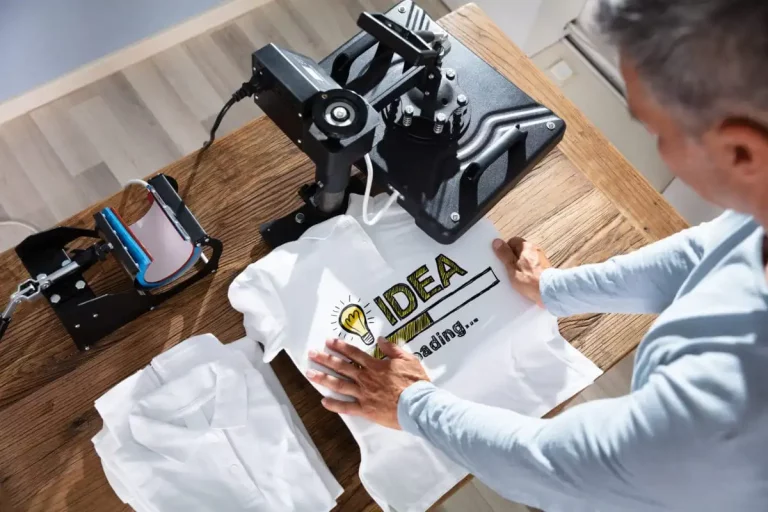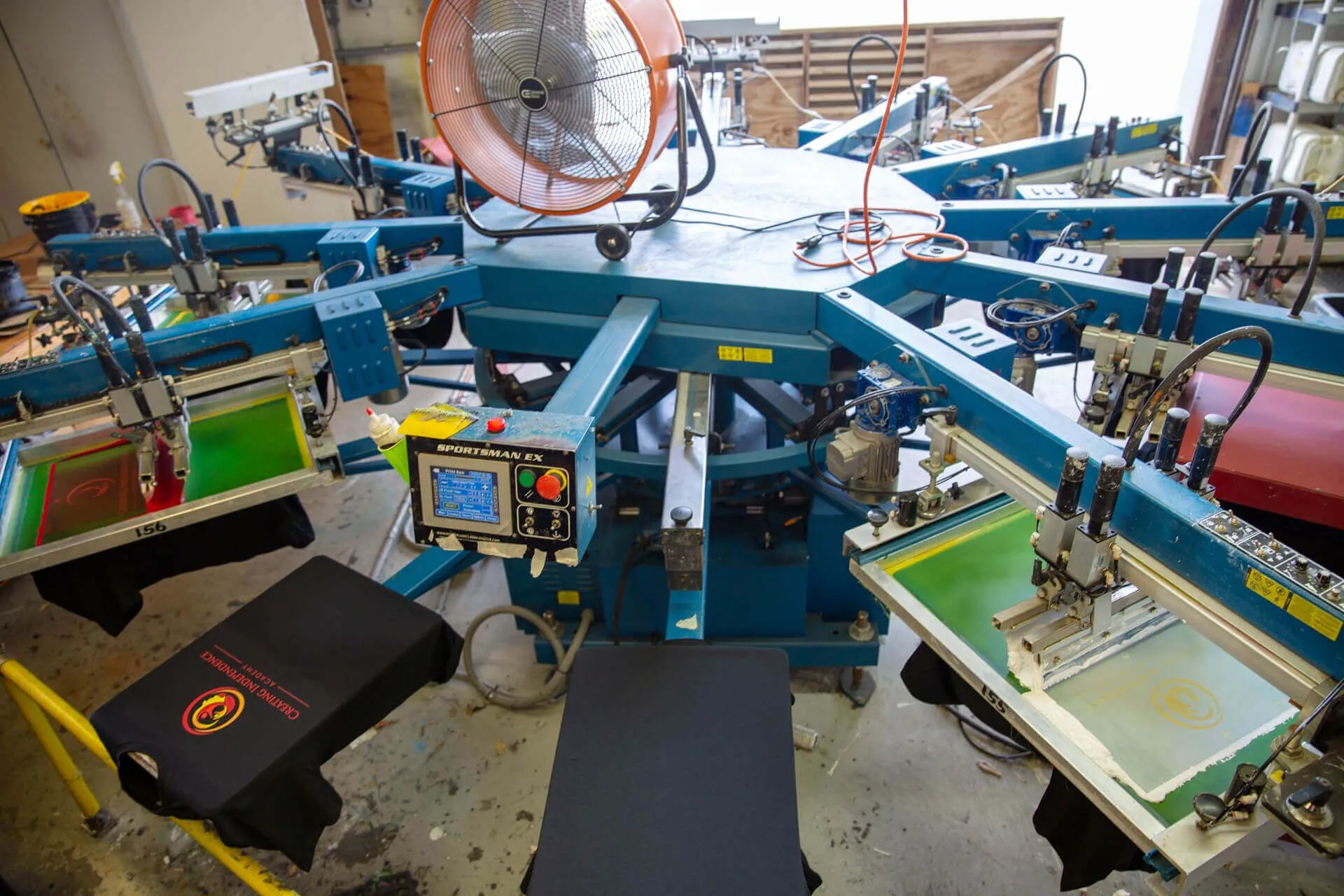Artistic Silk Screen Printing for Limited Edition Prints
Wiki Article
Display Printing Uncovered: Every Little Thing You Need to Understand About T-Shirt and Garment Printing Techniques
If you've ever wondered how those vibrant designs wind up on your favored t-shirts, you're in the appropriate location. Display printing is a fascinating approach that incorporates art with technique, using unlimited opportunities for imagination. Recognizing the basics, from devices to ink options, can considerably affect your results. All set to check out the important elements that make screen publishing an art kind? Let's uncover the details that can raise your projects.
The Fundamentals of Display Printing: How It Works
When you dive right into display printing, you'll find it's both an art and a science. At its core, display printing includes developing a stencil, or display, that permits ink to pass through just in particular locations.Following, you'll mix your inks and prepare your printing surface area. Placement the screen over the material, then utilize a squeegee to press ink with the display onto the garment. This process needs precision, as you desire clear, lively prints. After printing, you'll cure the ink with warmth, ensuring it complies with the material and lasts with washes. Each step is essential, and grasping them will boost your screen printing abilities, transforming easy garments right into one-of-a-kind, meaningful items.
Kinds Of Screen Printing Methods
As soon as you grasp the essentials of display printing, it's time to discover the various strategies that can elevate your styles. One popular method is typical display printing, where ink is pressed with a stenciled display. This technique is terrific for vibrant, vibrant colors. There's water-based ink printing, which provides a softer feeling and is environment-friendly, yet it requires a different strategy to treating.If you're intending for great information, consider discharge printing. This strategy eliminates dye from the fabric, leaving a soft, vintage look. One more choice is plastisol printing, known for its sturdiness and dazzling shades, making it a preferred for many brand names. Experiment with halftone printing to develop slope impacts and intricate styles. Each method has its special beauty, so don't wait to attempt them out to discover what matches your design best!
Important Equipment for Display Printing
To attain sensational outcomes in screen printing, having the ideal equipment is basic. You'll require a tough display printing frame, which holds the mesh that transfers your style onto the garment. Next, invest in top quality mops; these are essential for applying ink evenly throughout the screen.Selecting the Right Inks and Materials
When selecting inks and products for screen printing, you require to take into account the kind of ink that functions ideal for your task. Think regarding material compatibility to guarantee your designs look fantastic and last long. Discover green ink options to make your printing process much more sustainable.Types of Display Inks
Picking the right screen ink is necessary for attaining vibrant, resilient prints that fulfill your task's needs. There are numerous kinds of display inks to check out. Specialized inks, such as glow-in-the-dark or metallic, can add unique effects to your styles.
Textile Compatibility Factors To Consider
Comprehending material compatibility is essential for achieving high-grade screen prints, especially considering that various products respond distinctively to various inks. When selecting inks, think about the fabric kind-- cotton, polyester, or blends. For cotton, water-based inks function well, offering soft qualities and breathability. Polyester, on the various other hand, often calls for plastisol inks for far better attachment and lively colors. You might require to make use of a mix of both kinds if you're printing on blends. Always examine your inks on sample textile to ensure they stick effectively and keep color stability. Furthermore, keep in mind that fabric weight and texture can affect the final outcome, so picking the ideal ink and material combination is vital for your task's success.Eco-Friendly Ink Options
Environmentally friendly inks are coming to be a popular choice for screen printers who want to lessen their ecological effect while keeping quality. When selecting inks, think about water-based inks, which are much less unsafe and easier to cleanse up contrasted to conventional solvents.Additionally, try to find inks made from renewable energies, such as soy or vegetable-based alternatives. By selecting the ideal inks and materials, you'll not only create magnificent styles however likewise add to an extra sustainable printing process. Make the switch, and your prints will certainly mirror your dedication to the setting!
Preparing Your Layout for Display Printing

File Format Requirements
To ensure your layout looks sharp and vivid on fabric, you'll need to pay attention to file layout demands for screen printing. Beginning with vector documents like AI or EPS, as they can be scaled without losing quality. If you make use of raster images, select high-resolution files, such as TIFF or PNG, ideally at 300 DPI. Prevent utilizing JPEGs, as they can lose clearness when resized. Additionally, make certain your design has a transparent background to avoid undesirable white edges on your prints. Lastly, maintain color settings in mind; CMYK is common for display printing, so transform your RGB designs appropriately. By complying with these guidelines, you'll set your artwork up for an effective print.Color Splitting Up Techniques
Shade splitting up is an essential action in preparing your design for display printing, and understanding it can substantially improve your print high quality. You'll need to damage your layout into individual shades, as each color calls for a different screen during printing. Start by identifying all the colors in your design and develop layers for each one. You can use software like Adobe Photoshop or Illustrator to isolate and separate shades efficiently. Be specific to conserve each layer as a separate data, generally in a layout like TIFF or PSD. This precision not just ensures accurate shade representation screen printing kit however also streamlines the printing procedure. By focusing on shade separation, you'll achieve specialist and lively lead to your screen-printed garments.Resolution and Dimension
Accomplishing the very best outcomes in display printing starts with guaranteeing your layout has the best resolution and size. Preferably, your art work ought to go to the very least 300 DPI (dots per inch) for sharp, clear prints. If you make use of reduced resolution, your final item could look amateur and pixelated.When it concerns size, take into consideration the measurements of your print location. Style your artwork to match the last print dimension, ideally creating it in the real dimensions you'll be publishing. By doing this, you'll stay clear of any type of unexpected scaling issues.
Constantly check your style in both vector and raster formats. Vector graphics can be scaled without shedding quality, making them optimal for screen printing. Preparing appropriately will ensure your style looks fantastic on every garment!
Step-by-Step Screen Printing Refine
Screen printing is a vibrant procedure that permits you to produce lively styles on various surfaces. To get started, you'll need a display, solution, and your selected ink.Pour ink onto the display and use a squeegee to push the ink via the stencil onto the material. Raise the screen meticulously and allow the print completely dry. You've successfully screen printed your design.
Tips for Successful Screen Printing Projects
While you're diving into your screen printing tasks, bear in mind that preparation is essential to success. Begin by gathering all your materials-- inks, garments, squeegees, and screens. A clean work space aids avoid undesirable errors, so clean before you begin.Next, confirm your artwork is high-resolution and effectively sized for your garment. Test your display for correct exposure and tidy it completely to avoid spots. When blending your inks, adhere to the supplier's standards to accomplish the appropriate uniformity.
Throughout printing, use also stress with your squeegee for regular results. Don't hurry; take your time to confirm each print satisfies your standards. After printing, let your garments dry completely before managing or packaging them.
Lastly, constantly keep an example of your help future recommendation. In this manner, you can evaluate your progress and improve your techniques over time. Satisfied printing!

Regularly Asked Concerns
For how long Does It Require To Establish a Display Printing Task?
Setting up a display printing task usually takes about thirty minutes to an hour. You'll prepare the displays, mix inks, and adjust journalism. The time varies based upon complexity and experience, so remain organized!Can I Print on Various Material Types Using the Very Same Method?
Yes, you can print on various textile kinds making use of the same strategy, however you'll require to change your setups and inks. Some fabrics take in ink in a different way, so experimenting warranties the very best outcomes for every product.What Prevail Blunders to Prevent in Display Printing?
When screen printing, prevent usual errors like making use of the wrong ink, ignoring proper exposure times, or missing pre-press checks. Always examine your setup and preserve tidy screens to assure quality outcomes each time.How Can I Appropriately Tidy and Keep My Screen Printing Devices?
To effectively clean and preserve your display printing equipment, you must consistently clean screens with ideal solvents, check mops for wear, and guarantee all devices are kept dust-free and completely dry. Consistency prevents expensive repair services and improves efficiency.Is Screen Printing Eco-friendly Compared to Other Methods?
Screen printing can be much more eco-friendly than various other approaches, specifically if you make use of eco-conscious materials and water-based inks. By choosing sustainable products and techniques, you reduce waste and minimize your effect on the planet.Screen Printing Uncovered: Everything You Need to Know About Tee Shirt and Garment Printing Methods
At its core, display printing includes developing a pattern, or display, that permits ink to pass through just in details areas. Position the display over the material, then use a squeegee to push ink through the display onto the garment. One prominent technique is conventional screen printing, where ink is pressed with a stenciled screen.When picking inks and products for screen printing, you require to take right into account the type of ink that works best for your task.
Report this wiki page